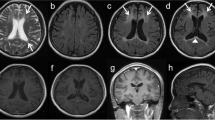Abstract
We report two autopsy cases of siblings with adult-onset autosomal dominant leukodystrophy characterized by destruction of cerebral white matter, large numbers of axonal spheroids and pigmented glia in the fronto-temporal lobes. Both patients presented with motor and cognitive symptoms and aphasia, 2–3 years before death. At autopsy, the brain showed brown coloration and decreased volume of white matter in the frontal and temporal lobes as well as corpus callosum. Microscopically, marked loss of myelin and axons and abundant axonal spheroids without apparent neuronal loss were observed in the frontal and temporal lobes, which was consistent with hereditary diffuse leukodystrophy with spheroids (HDLS). In addition, glial cells, most consistent with macrophages and containing pigments that were stained by Sudan III and PAS, were found in the white matter lesions. The present cases showed overlapping features with HDLS and pigmentary type of orthochromatic leukodystrophy, suggesting that the pathomechanisms of these two diseases are closely related.








Similar content being viewed by others
References
Axelsson R, Roytta M, Sourander P, Akesson HO, Andersen O (1984) Hereditary diffuse leucoencephalopathy with spheroids. Acta Psychiatr Scand Suppl 314:1–65
Constantinidis J, Wisniewski TM (1991) The dominant form of the pigmentary orthochromatic leukodystrophy. Acta Neuropathol 82:483–487
Knopman D, Sung JH, Davis D (1996) Progressive familial leukodystrophy of late onset. Neurology 46:429–434
Marotti JD, Tobias S, Fratkin JD, Powers JM, Rhodes CH (2004) Adult onset leukodystrophy with neuroaxonal spheroids and pigmented glia: report of a family, historical perspective, and review of the literature. Acta Neuropathol 107:481–488
Okeda R, Matsuo T, Kawahara Y, Eishi Y, Tamai Y, Tanaka M, Kamaki M, Tsubota N, Yamadera H (1989) Adult pigment type (Peiffer) of sudanophilic leukodystrophy. Pathological and morphometrical studies on two autopsy cases of siblings. Acta Neuropathol 78:533–542
Peiffer J (1970) The pure leucodystrophic forms of orthochromatic leucodystrophies (simple type, pigment type). Handb Clin Neurol 10:105–119
Pietrini V, Tagliavini F, Pilleri G, Trabattoni CR, Lechi A (1979) Orthochromatic leukodystrophy with pigmented glial cells. An adult case with clinical-anatomical study. Acta Neurol Scand 59:140–147
Seiser A, Jellinger K, Brainin M (1990) Pigmentary type of orthochromatic leukodystrophy with early onset and protracted course. Neuropediatrics 21:48–52
Shannon P, Wherrett JR, Nag S (1997) A rare form of adult onset leukodystrophy: orthochromatic leukodystrophy with pigmented glia. Can J Neurol Sci 24:146–150
Sotrel A (1988) On the dual nature and lack of specificity of intracytoplasmic inclusions in a case of adult onset orthochromatic leukodystrophy. J Neuropathol Exp Neurol 47:490–492
Terada S, Ishizu H, Yokota O, Ishihara T, Nakashima H, Kugo A, Tanaka Y, Nakashima T, Nakashima Y, Kuroda S (2004) An autopsy case of hereditary diffuse leukoencephalopathy with spheroids, clinically suspected of Alzheimer’s disease. Acta Neuropathol 108:538–545
Tunon T, Ferrer I, Gallego J, Delgado G, Villanueva JA, Martinez-Penuela JM (1988) Leucodystrophy with pigmented glial and scavenger cells (pigmentary type of orthochromatic leucodystrophy). Neuropathol Appl Neurobiol 14:337–344
Van Bogaert L, Nyssen R (1936) Le type tardif de la leukodystrophie progressive familiale. Rev Neurol (Paris) 65:21–45
van der Knaap MS, Naidu S, Kleinschmidt-Demasters BK, Kamphorst W, Weinstein HC (2000) Autosomal dominant diffuse leukoencephalopathy with neuroaxonal spheroids. Neurology 54:463–468
Verghese J, Weidenheim K, Malik S, Rapin I (2002) Adult onset pigmentary orthochromatic leukodystrophy with ovarian dysgenesis. Eur J Neurol 9:663–670
Yamashita M, Yamamoto T (2002) Neuroaxonal leukoencephalopathy with axonal spheroids. Eur Neurol 48:20–25
Yazawa I, Nakano I, Yamada H, Oda M (1997) Long tract degeneration in familial sudanophilic leukodystrophy with prominent spheroids. J Neurol Sci 147:185–191
Acknowledgement
The authors would like to thank Dr. Kei Yamada for his critical comments on the manuscript.
Author information
Authors and Affiliations
Corresponding author
Rights and permissions
About this article
Cite this article
Itoh, K., Shiga, K., Shimizu, K. et al. Autosomal dominant leukodystrophy with axonal spheroids and pigmented glia: clinical and neuropathological characteristics. Acta Neuropathol 111, 39–45 (2006). https://doi.org/10.1007/s00401-005-1113-6
Received:
Revised:
Accepted:
Published:
Issue Date:
DOI: https://doi.org/10.1007/s00401-005-1113-6




